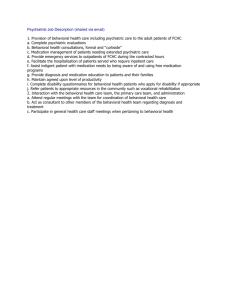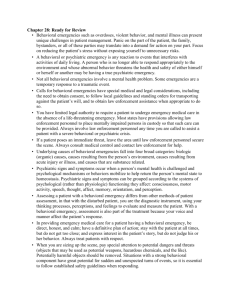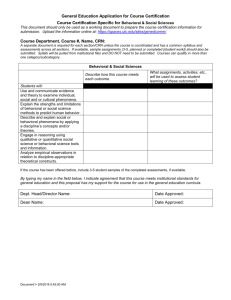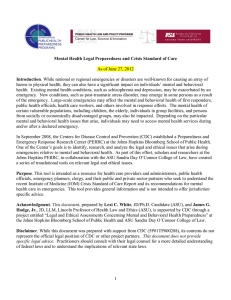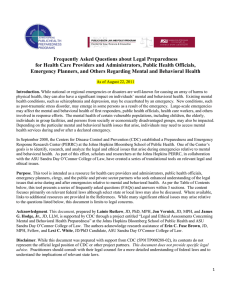Chapter 21
advertisement
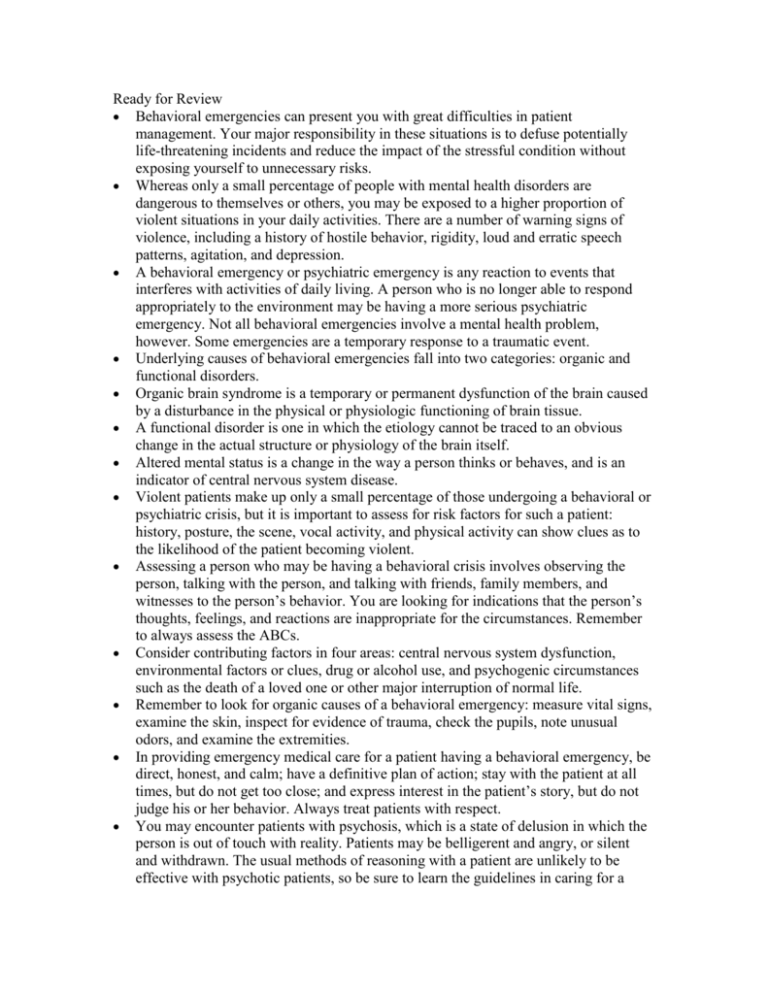
Ready for Review Behavioral emergencies can present you with great difficulties in patient management. Your major responsibility in these situations is to defuse potentially life-threatening incidents and reduce the impact of the stressful condition without exposing yourself to unnecessary risks. Whereas only a small percentage of people with mental health disorders are dangerous to themselves or others, you may be exposed to a higher proportion of violent situations in your daily activities. There are a number of warning signs of violence, including a history of hostile behavior, rigidity, loud and erratic speech patterns, agitation, and depression. A behavioral emergency or psychiatric emergency is any reaction to events that interferes with activities of daily living. A person who is no longer able to respond appropriately to the environment may be having a more serious psychiatric emergency. Not all behavioral emergencies involve a mental health problem, however. Some emergencies are a temporary response to a traumatic event. Underlying causes of behavioral emergencies fall into two categories: organic and functional disorders. Organic brain syndrome is a temporary or permanent dysfunction of the brain caused by a disturbance in the physical or physiologic functioning of brain tissue. A functional disorder is one in which the etiology cannot be traced to an obvious change in the actual structure or physiology of the brain itself. Altered mental status is a change in the way a person thinks or behaves, and is an indicator of central nervous system disease. Violent patients make up only a small percentage of those undergoing a behavioral or psychiatric crisis, but it is important to assess for risk factors for such a patient: history, posture, the scene, vocal activity, and physical activity can show clues as to the likelihood of the patient becoming violent. Assessing a person who may be having a behavioral crisis involves observing the person, talking with the person, and talking with friends, family members, and witnesses to the person’s behavior. You are looking for indications that the person’s thoughts, feelings, and reactions are inappropriate for the circumstances. Remember to always assess the ABCs. Consider contributing factors in four areas: central nervous system dysfunction, environmental factors or clues, drug or alcohol use, and psychogenic circumstances such as the death of a loved one or other major interruption of normal life. Remember to look for organic causes of a behavioral emergency: measure vital signs, examine the skin, inspect for evidence of trauma, check the pupils, note unusual odors, and examine the extremities. In providing emergency medical care for a patient having a behavioral emergency, be direct, honest, and calm; have a definitive plan of action; stay with the patient at all times, but do not get too close; and express interest in the patient’s story, but do not judge his or her behavior. Always treat patients with respect. You may encounter patients with psychosis, which is a state of delusion in which the person is out of touch with reality. Patients may be belligerent and angry, or silent and withdrawn. The usual methods of reasoning with a patient are unlikely to be effective with psychotic patients, so be sure to learn the guidelines in caring for a psychotic patient, including being calm, direct, straightforward, and nonconfrontational. The threat of suicide requires immediate intervention. Depression is the most significant risk factor for suicide. Other risk factors include personal or family history of suicide attempts, chronic debilitating illness, financial setback, and severe mental illness. You may encounter patients with agitated delirium. This is impairment of cognitive function that can present with disorientation, hallucinations, or delusions, and is characterized by restless and irregular physical activity. One of the most important factors to consider when caring for these patients is your personal safety. Use careful interviewing techniques and refrain from upsetting the patient further. As an AEMT, you have limited legal authority to require a patient to undergo emergency medical care in the absence of a life-threatening emergency. Most states have provisions allowing law enforcement personnel to place mentally impaired persons in custody so that such care can be provided. You should always involve law enforcement personnel any time you are called to assist a patient with a severe behavioral or psychiatric crisis. Always consult medical control and contact law enforcement for help before restraining a patient. If the patient poses an immediate threat, leave the area until law enforcement secures the scene. If restraints are required, use the minimum force necessary. Assess the airway and circulation frequently while the patient is restrained, and maintain a constant dialogue with the patient throughout the restraining process.


